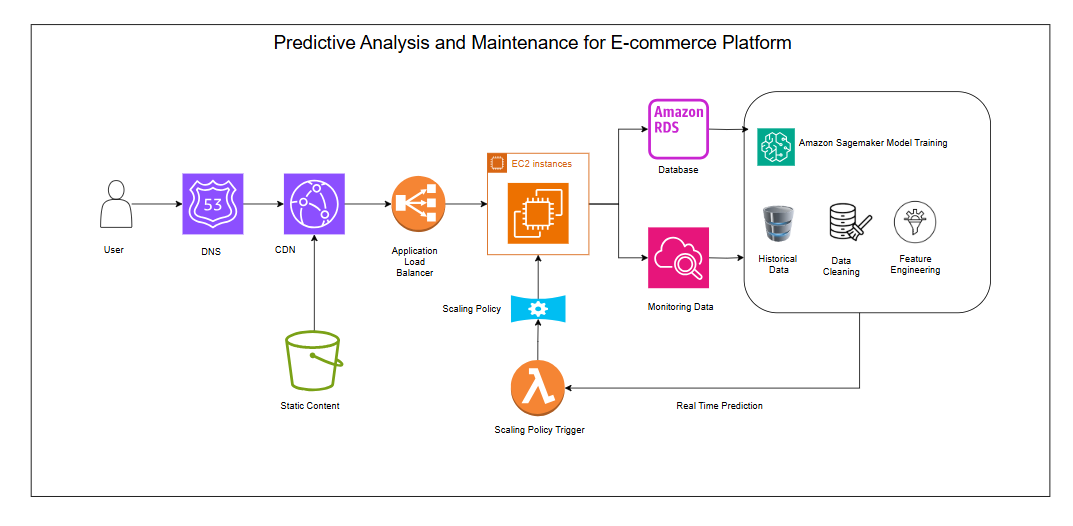
Harness the Power of Predictive Maintenance to Minimize Downtime
Foundation of Our Approach
Businesses using predictive maintenance experience around 15%* less downtime, helping them plan better and prevent unexpected breakdowns. Industries like aviation, manufacturing, and energy are already leveraging data-driven insights to improve reliability. As technology advances, predictive maintenance will become even more essential, driving efficiency and innovation in daily operations. (Source: Deloitte)* E-commerce platforms often face significant fluctuations in traffic, particularly during holiday seasons, flash sales, or product launches. Managing cloud resources dynamically is essential to avoid over-provisioning, which incurs unnecessary costs, and under-provisioning, which can lead to poor customer experiences and downtime. To address this problem, an e-commerce company implemented predictive analytics to forecast traffic spikes by analyzing historical sales data alongside external factors such as holidays and promotions. This data-driven approach enabled the platform to anticipate user numbers and the corresponding server load during high-demand periods. By employing a predictive auto-scaling strategy, the platform dynamically adjusted its computing resources ahead of anticipated traffic surges. Machine learning models, trained on past shopping behavior, predicted future demand, allowing the system to scale resources without delays, thereby maintaining optimal performance proactively. As a result, the platform achieved a 25% reduction in over-provisioning costs, improved performance during peak times by 40% with fewer slowdowns or crashes, and increased customer satisfaction due to faster load times and seamless transactions.

Dynamic Scaling for E-commerce Platform
- Traffic Management: Users access the platform via Amazon Route 53 and Amazon CloudFront for optimized content delivery. Traffic is routed through an Application Load Balancer to handle dynamic workloads.
- Dynamic Resource Scaling: Auto Scaling Groups manage backend EC2 instances, dynamically adjusting resources based on demand. Static assets are served directly from Amazon S3 for improved performance.
- Data-Driven Predictions: Amazon SageMaker trains machine learning models using historical data (e.g., sales, traffic patterns, holidays). Live data ingested via database into SageMaker for immediate predictions.
- Real-Time Scaling Actions: Predictions from SageMaker trigger AWS Lambda to adjust scaling policies, pre-warm caches, and optimize database replicas. This ensures seamless performance during peak events.
- Monitoring and Feedback: AWS CloudWatch monitors system metrics, generating alerts and providing insights to refine predictive models.
This architecture demonstrates a scalable and efficient solution for managing fluctuating traffic on an e-commerce platform using AWS services and predictive analytics.

The following outlines the detailed components breakdown and processes involved in this initiative.
Components
- Before Predictive Scaling: Higher CPU and memory usage, with peaks potentially leading to over-provisioning or resource shortages.
- After Predictive Scaling: Improved allocation with reduced peaks, staying within an optimal range without over-provisioning.
How It Works
- Data Collection: User activity data (web analytics, mobile app logs, feedback, purchase history) is captured and streamed to Amazon Kinesis in real time.
- Data Processing: AWS Lambda processes the data, storing image data in Amazon S3 and semi-structured data in Amazon DynamoDB.
- Model Training: Amazon SageMaker uses historical data for cleaning, feature engineering, and training churn prediction models.
- Real-Time Predictions: Live data is fed into SageMaker models for real-time churn prediction.
- Retention Strategies: Predictions trigger AWS Lambda, which executes personalized retention strategies like discounts or offers.
- Customer Engagement: Amazon Pinpoint sends targeted marketing content (emails, SMS, push notifications) based on retention strategies.
- Monitoring: AWS CloudWatch monitors system performance and provides feedback for refining models.
- Outcome: This workflow reduces churn by proactively engaging at-risk users and ensuring seamless performance.
Give Your Operations the Competitive Edge
- Cost Optimization: 25% reduction in over-provisioning costs.
- Performance Improvement: 40% better load handling during traffic spikes.
- Enhanced User Experience: Faster page loads and seamless transactions.
Reach out to our experts to discover how combining predictive analytics with real-time resource management can boost the scalability and efficiency required for a robust e-commerce solution.